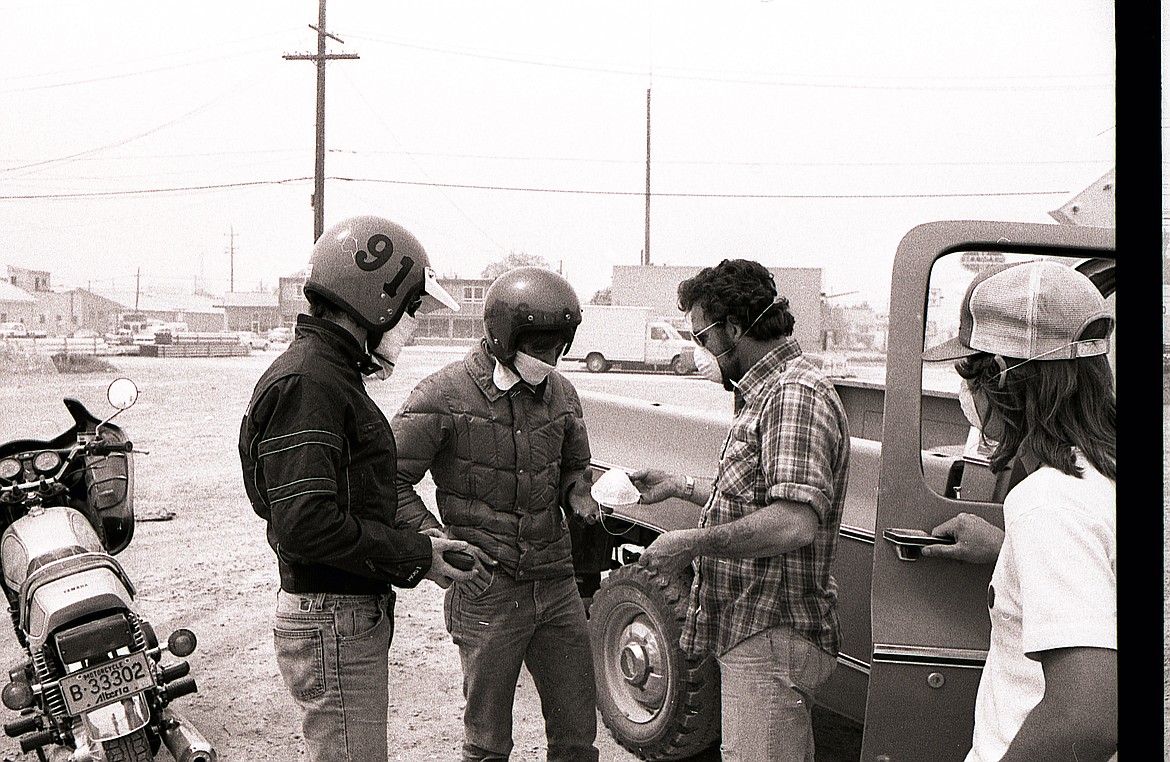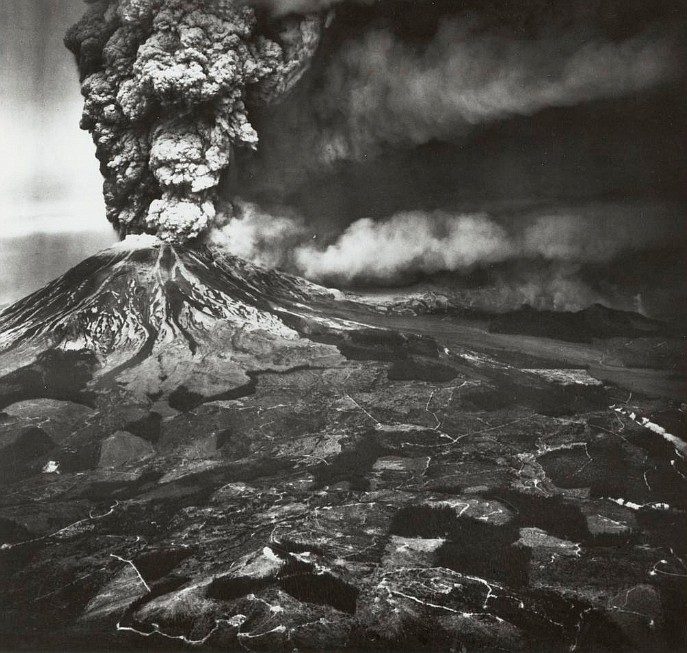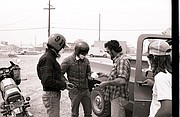Memories still vivid 40 years after Mount St. Helens eruption
No one knew in the early morning hours of May 18, 1980, what catastrophe the day would bring.
The eruption of Mount St. Helens four decades ago was an event that changed lives forever, and took the lives of 57. It nearly instantly changed the sciences of volcanology and ecology, and forever etched its images in the minds of those who lived through it.
As the 40th anniversary of that fateful day approaches, many area residents have reached out to share their stories of how the eruption affected their lives and the lives of those around them.
IT BEGAN just like any other Sunday. In Portland, Oregon, 19-year-old twin sisters Mary and Martha Munter had just finished the semester at Multnomah University and had decided to leave at 6 in the morning to make the trip back home to Kalispell.
In Kalispell, Doug Rauthe and his wife were walking into church when they heard a strange noise they could not place.
Four hundred miles away, logger Mark Abernathy was also getting ready for church just 20 miles from Mount St. Helens and, just a few miles down the road, Rauthe’s aunt and uncle, Nelda and Tom Morgan, had no idea they were walking out of their house for the last time.
While the eruption came on May 18, activity on the volcano had begun more than a month earlier when the U.S. Geological Survey detected a small earthquake March 20. For a little more than a week, the earthquakes intensified in frequency and strength, with 174 tremors recorded from March 25-27 until the first signs of volcanic activity became visible at the surface. The mountain experienced five magnitude 4 or greater earthquakes per day in early April and as many as eight per day in the week leading up to the eruption.
Washington Gov. Dixy Lee Ray issued an executive order April 30 creating a “Red Zone” around the top of the mountain in an effort to protect residents from an eruption, but the zone was as close as 3 miles to the summit at some points and meant little to the loggers and homeowners in the area.
For Nelda and Tom Morgan, it had become a daily routine to leave their home some 25 miles down the North Fork of the Toutle River every morning to check on the status of the mountain.
“We had been watching the mountain since it started puffing in March,” Nelda Morgan, now 93, recalled from her home in Kalispell. “We would drive up about every morning to get a better look. Thank goodness we didn’t go up that Sunday it blew. We never dreamed it would take out the whole side of the mountain.”
For weeks, geologists had been coming, by advising everyone along the river to put their most valuable belongings at least 15 feet above the water level. Nelda and Tom moved everything into the upstairs of their three-bedroom home — it wouldn’t do them, or anyone else in their neighborhood, any good.
THE LARGEST volcanic blast in American history started with an earthquake.
At precisely 8:32:17 on the clear, cloudless morning of Sunday, May 18, 1980, a magnitude 5.1 earthquake struck 1 mile below the surface of the north side of Mount St. Helens. The quake was enough to split open the crack that had been forming across the face of the mountain and release the largest landslide in recorded history. Moments later, the eruption began.
Nelda and Tom never heard or felt a thing. As the couple walked out of the house to make the trip to their cabin, located 5 miles closer to the mountain, Tom froze as he looked up to the sky.
“We got up that morning and there was no quake, no sound, no nothing,” Nelda remembered. “My husband went out to get in his pickup and I heard him say ‘Oh my God! Look at the sky.’ ... We did the only thing we could, we left.”
Five miles up the road, near Nelda and Tom’s cabin, Weyerhaeuser logger Mark Abernathy was getting ready for church when he looked up and saw the cloud of ash, gas and debris begin to rise in the morning sky. As the devastation made its way down the mountain, he knew the only thing that had saved his life, and the lives of hundreds of his fellow loggers, was that the destruction was happening on a Sunday.
“I thought for sure we were all going to get buried in ash that kept falling, but the wind picked up and took a lot of it east,” he recalled.
MARTHA AND Mary Munter of Kalispell were approximately 40 miles southeast of the mountain when the eruption began, somewhere between Biggs Junction and Arlington, Oregon. Traveling mainly east at that point, they would not notice the ominous cloud rising behind them for some time. They did not know it yet, but their race against that cloud and the destructive ash it carried had just begun.
“We had a Fiat — a little tin can with a stick shift. We couldn’t get any radio, so we had no idea it had erupted. It wasn’t until we got on the road between Tri Cities and Ritzville that we looked behind us and noticed this giant stormy cloud rising up to the west,” Martha recalled.
“It just didn’t look right. It didn’t look like a storm cloud, but it was huge. It covered the whole horizon and we could see lightning in it, but there was just something not right about it,” Mary added.
After stopping for gas outside Ritzville, the pair learned about the eruption and were advised to seek shelter to avoid having the falling ash damage their car. Faced with a tough decision, they decided to press on.
CLOSER TO the mountain, Nelda and Tom were frantically trying to reach safety. They were among the last people to cross the Toutle River Bridge on State Road 504 before authorities were forced to close it. The bridge was later destroyed by debris. The couple had just reached a friend’s house in Silver Lake when they were forced to evacuate to Castle Rock. They had barely arrived there when authorities made them leave once again. Hours later they would finally settle in with other evacuated residents in Shelton, northwest of Olympia. Fearing the worst, both their families could only watch the television coverage of the eruption in hopes of seeing them. Nelda and Tom were not spotted, but their house was — as it floated down the Toutle River and was destroyed smashing into the very bridge they had been the last to cross. Their families would not learn they had survived for more than a week.
To the east, in Spokane, the ash cloud was closing in on Mary and Martha. Ever at their back, the dark cloud of destructive ash was closer than ever.
Determined to make it home, they pushed onward, reaching Kalispell less than an hour before the ash began falling.
“We got home around supper time and I wanted to go inside, but Martha said we should get all of our belongings out of the car first,” Mary said. “It’s a good thing we did, because the ash started coming down right as we were finishing up. We didn’t leave the house again for three days.”
About the time Mary and Martha made their escape from Spokane, Flathead High School senior Jane Hammett and her friends were taking in Riverside Park as part of their concert choir trip to the Lilac City.
“We were walking around the park when the sky started getting very black. Then it started snowing. It took us a moment to realize it was ash, not snow,” she recalled. “It was a massive black cloud with no real shape — a giant black mass that covered the whole horizon and it was descending upon Spokane. It was spooky and I will never forget it.”
Not sure what to do, Hammett and her friends retreated to a nearby candy store for shelter. Enjoying the free samples, they could only watch as the world turned gray.
They eventually made it back to the Holiday Inn to meet up with the rest of the choir, but the group would be stuck at the hotel for three days.
Choir Director Don Goddard did arrange for his group to perform a “fallout concert” for other guests trapped at the hotel.
Hammett said she got a real sense of the situation when she and a few friends decided to sneak out of the hotel one night.
“It was like a nuclear bomb had gone off. It was dead quiet and deserted and ash was falling from the sky.”
FOR MANY, that day is a painful memory that will never go away. Nelda and Tom lost everything they owned when their house was swept away by the Toutle River. They escaped with only the clothes on their backs and the surveying equipment in the back of Tom’s pickup.
To this day, she finds the event hard to talk about, having never given a public accounting of her story until now. She still cringes when she sees the footage of her house crashing into the Toutle River Bridge, a video clip that remains popular in Mount St. Helens documentaries.
A single hanging flower basket was all that was ever found of her house and she never returned to the property where their cabin had once stood.
Reporter Jeremy Weber may be reached at 758-4446 or jweber@dailyinterlake.com.





